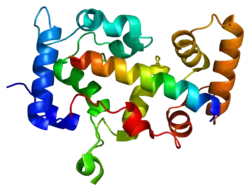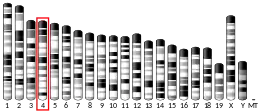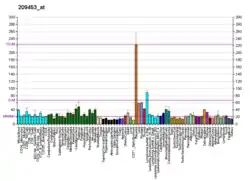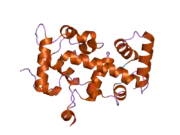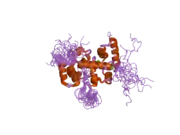Sodium–hydrogen antiporter 1
The sodium-hydrogen antiporter 1 (NHE-1) also known as sodium/hydrogen exchanger 1 or SLC9A1 (SoLute Carrier family 9A1) is an isoform of sodium–hydrogen antiporter that in humans is encoded by the SLC9A1 gene.[5]
Function
The Na+/H+ antiporter (SLC9A1) is a ubiquitous membrane-bound enzyme involved in volume- and pH-regulation of vertebrate cells. It is inhibited by the non-specific diuretic drug amiloride and activated by a variety of signals including growth factors, mitogens, neurotransmitters, tumor promoters, and others.[6]
Interactions
Sodium–hydrogen antiporter 1 has been shown to interact with carbonic anhydrase II[7] and CHP.[8][9][10] It is also the target of the experimental drug rimeporide, which is being developed for the treatment of Duchenne muscular dystrophy.[11]
References
- GRCh38: Ensembl release 89: ENSG00000090020 - Ensembl, May 2017
- GRCm38: Ensembl release 89: ENSMUSG00000028854 - Ensembl, May 2017
- "Human PubMed Reference:". National Center for Biotechnology Information, U.S. National Library of Medicine.
- "Mouse PubMed Reference:". National Center for Biotechnology Information, U.S. National Library of Medicine.
- Fliegel L, Dyck JR, Wang H, Fong C, Haworth RS (August 1993). "Cloning and analysis of the human myocardial Na+/H+ exchanger". Molecular and Cellular Biochemistry. 125 (2): 137–43. doi:10.1007/BF00936442. PMID 8283968. S2CID 24360200.
- Cardone RA, Alfarouk KO, Elliott RL, Alqahtani SS, Ahmed SB, Aljarbou AN, et al. (July 2019). "The Role of Sodium Hydrogen Exchanger 1 in Dysregulation of Proton Dynamics and Reprogramming of Cancer Metabolism as a Sequela". International Journal of Molecular Sciences. 20 (15): 3694. doi:10.3390/ijms20153694. PMC 6696090. PMID 31357694.
- Li X, Alvarez B, Casey JR, Reithmeier RA, Fliegel L (September 2002). "Carbonic anhydrase II binds to and enhances activity of the Na+/H+ exchanger". The Journal of Biological Chemistry. 277 (39): 36085–91. doi:10.1074/jbc.M111952200. PMID 12138085.
- Inoue H, Nakamura Y, Nagita M, Takai T, Masuda M, Nakamura N, Kanazawa H (February 2003). "Calcineurin homologous protein isoform 2 (CHP2), Na+/H+ exchangers-binding protein, is expressed in intestinal epithelium". Biological & Pharmaceutical Bulletin. 26 (2): 148–55. doi:10.1248/bpb.26.148. PMID 12576672.
- Lin X, Barber DL (October 1996). "A calcineurin homologous protein inhibits GTPase-stimulated Na-H exchange". Proceedings of the National Academy of Sciences of the United States of America. 93 (22): 12631–6. Bibcode:1996PNAS...9312631L. doi:10.1073/pnas.93.22.12631. PMC 38044. PMID 8901634.
- Pang T, Su X, Wakabayashi S, Shigekawa M (May 2001). "Calcineurin homologous protein as an essential cofactor for Na+/H+ exchangers". The Journal of Biological Chemistry. 276 (20): 17367–72. doi:10.1074/jbc.M100296200. PMID 11350981.
- Spreitzer, Helmut (26 May 2015). "Rimeporide". Österreichische Apothekerzeitung (in German). 69 (11): 12.
Further reading
- Yu L, Quinn DA, Garg HG, Hales CA (June 2008). "Deficiency of the NHE1 gene prevents hypoxia-induced pulmonary hypertension and vascular remodeling". American Journal of Respiratory and Critical Care Medicine. 177 (11): 1276–84. doi:10.1164/rccm.200710-1522OC. PMC 2408441. PMID 18310478.
- Rios EJ, Fallon M, Wang J, Shimoda LA (November 2005). "Chronic hypoxia elevates intracellular pH and activates Na+/H+ exchange in pulmonary arterial smooth muscle cells". American Journal of Physiology. Lung Cellular and Molecular Physiology. 289 (5): L867–74. doi:10.1152/ajplung.00455.2004. PMID 15964895. S2CID 16399637.
- Cingolani HE, Ennis IL (March 2007). "Sodium-hydrogen exchanger, cardiac overload, and myocardial hypertrophy". Circulation. 115 (9): 1090–100. doi:10.1161/CIRCULATIONAHA.106.626929. PMID 17339567.
- Meima ME, Mackley JR, Barber DL (July 2007). "Beyond ion translocation: structural functions of the sodium-hydrogen exchanger isoform-1". Current Opinion in Nephrology and Hypertension. 16 (4): 365–72. doi:10.1097/MNH.0b013e3281bd888d. PMID 17565280. S2CID 25616109.
- Tse CM, Ma AI, Yang VW, Watson AJ, Levine S, Montrose MH, et al. (August 1991). "Molecular cloning and expression of a cDNA encoding the rabbit ileal villus cell basolateral membrane Na+/H+ exchanger". The EMBO Journal. 10 (8): 1957–67. doi:10.1002/j.1460-2075.1991.tb07725.x. PMC 452875. PMID 1712287.
- Dudley CR, Giuffra LA, Tippett P, Kidd KK, Reeders ST (November 1990). "The Na+/H+ antiporter: a "melt" polymorphism allows regional mapping to the short arm of chromosome 1". Human Genetics. 86 (1): 79–83. doi:10.1007/bf00205179. PMID 1979310. S2CID 20107780.
- Sardet C, Counillon L, Franchi A, Pouysségur J (February 1990). "Growth factors induce phosphorylation of the Na+/H+ antiporter, glycoprotein of 110 kD". Science. 247 (4943): 723–6. Bibcode:1990Sci...247..723S. doi:10.1126/science.2154036. PMID 2154036.
- Sardet C, Franchi A, Pouysségur J (January 1989). "Molecular cloning, primary structure, and expression of the human growth factor-activatable Na+/H+ antiporter". Cell. 56 (2): 271–80. doi:10.1016/0092-8674(89)90901-X. PMID 2536298. S2CID 2782563.
- Mattei MG, Sardet C, Franchi A, Pouysségur J (1988). "The human amiloride-sensitive Na+/H+ antiporter: localization to chromosome 1 by in situ hybridization". Cytogenetics and Cell Genetics. 48 (1): 6–8. doi:10.1159/000132575. PMID 2846238.
- Counillon L, Pouysségur J, Reithmeier RA (August 1994). "The Na+/H+ exchanger NHE-1 possesses N- and O-linked glycosylation restricted to the first N-terminal extracellular domain". Biochemistry. 33 (34): 10463–9. doi:10.1021/bi00200a030. PMID 8068684.
- Fliegel L, Dyck JR, Wang H, Fong C, Haworth RS (August 1993). "Cloning and analysis of the human myocardial Na+/H+ exchanger". Molecular and Cellular Biochemistry. 125 (2): 137–43. doi:10.1007/BF00936442. PMID 8283968. S2CID 24360200.
- Lin X, Barber DL (October 1996). "A calcineurin homologous protein inhibits GTPase-stimulated Na-H exchange". Proceedings of the National Academy of Sciences of the United States of America. 93 (22): 12631–6. Bibcode:1996PNAS...9312631L. doi:10.1073/pnas.93.22.12631. PMC 38044. PMID 8901634.
- Shrode LD, Gan BS, D'Souza SJ, Orlowski J, Grinstein S (August 1998). "Topological analysis of NHE1, the ubiquitous Na+/H+ exchanger using chymotryptic cleavage". The American Journal of Physiology. 275 (2): C431-9. doi:10.1152/ajpcell.1998.275.2.C431. PMID 9688597.
- Wakabayashi S, Pang T, Su X, Shigekawa M (March 2000). "A novel topology model of the human Na(+)/H(+) exchanger isoform 1". The Journal of Biological Chemistry. 275 (11): 7942–9. doi:10.1074/jbc.275.11.7942. PMID 10713111.
- Garden OA, Musk P, Worthington-White DA, Dewey MJ, Rich IN (July 2000). "Silent polymorphisms within the coding region of human sodium/hydrogen exchanger isoform-1 cDNA in peripheral blood mononuclear cells of leukemia patients: A comparison with healthy controls". Cancer Genetics and Cytogenetics. 120 (1): 37–43. doi:10.1016/S0165-4608(99)00246-0. PMID 10913675.
- Denker SP, Huang DC, Orlowski J, Furthmayr H, Barber DL (December 2000). "Direct binding of the Na--H exchanger NHE1 to ERM proteins regulates the cortical cytoskeleton and cell shape independently of H(+) translocation". Molecular Cell. 6 (6): 1425–36. doi:10.1016/S1097-2765(00)00139-8. PMID 11163215.
- Lehoux S, Florian JA, Berk BC (May 2001). "14-3-3 Binding to Na+/H+ exchanger isoform-1 is associated with serum-dependent activation of Na+/H+ exchange". The Journal of Biological Chemistry. 276 (19): 15794–800. doi:10.1074/jbc.M100410200. PMID 11279064.
- Pang T, Su X, Wakabayashi S, Shigekawa M (May 2001). "Calcineurin homologous protein as an essential cofactor for Na+/H+ exchangers". The Journal of Biological Chemistry. 276 (20): 17367–72. doi:10.1074/jbc.M100296200. PMID 11350981.
- Yan W, Nehrke K, Choi J, Barber DL (August 2001). "The Nck-interacting kinase (NIK) phosphorylates the Na+-H+ exchanger NHE1 and regulates NHE1 activation by platelet-derived growth factor". The Journal of Biological Chemistry. 276 (33): 31349–56. doi:10.1074/jbc.M102679200. PMID 11369779.
- Khaled AR, Moor AN, Li A, Kim K, Ferris DK, Muegge K, et al. (November 2001). "Trophic factor withdrawal: p38 mitogen-activated protein kinase activates NHE1, which induces intracellular alkalinization". Molecular and Cellular Biology. 21 (22): 7545–57. doi:10.1128/MCB.21.22.7545-7557.2001. PMC 99926. PMID 11604491.
- Mailänder J, Müller-Esterl W, Dedio J (November 2001). "Human homolog of mouse tescalcin associates with Na(+)/H(+) exchanger type-1". FEBS Letters. 507 (3): 331–5. doi:10.1016/S0014-5793(01)02986-6. PMID 11696366.
- Shen MR, Wilkins RJ, Chou CY, Ellory JC (February 2002). "Anion exchanger isoform 2 operates in parallel with Na(+)/H(+) exchanger isoform 1 during regulatory volume decrease of human cervical cancer cells". FEBS Letters. 512 (1–3): 52–8. doi:10.1016/S0014-5793(01)03317-8. PMID 11852051.
- Behne MJ, Meyer JW, Hanson KM, Barry NP, Murata S, Crumrine D, et al. (December 2002). "NHE1 regulates the stratum corneum permeability barrier homeostasis. Microenvironment acidification assessed with fluorescence lifetime imaging". The Journal of Biological Chemistry. 277 (49): 47399–406. doi:10.1074/jbc.M204759200. PMID 12221084.
